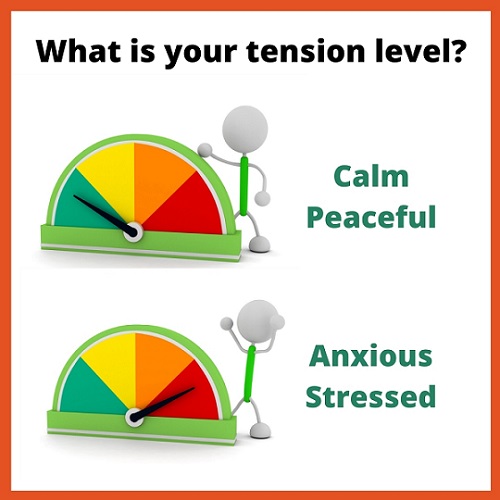Feeling Peace of Mind Versus Anxiety
by Kathy Slattengren, M. Ed., Priceless Parenting (sign up for monthly parenting newsletter and receive 20+ printable charts for kids and parents)
(listen to article read by the author)

How often are your kids in a calm, peaceful state? Kids do their best when they are feeling safe and calm. Being in a
calm emotional state is essential for optimal learning.
Football quarterbacks also perform their best when they are calm and focused. They can take in the big picture, avoid getting sacked and complete amazing passes. You can see it in their eyes when they are calm versus frazzled. Once they are frazzled, they make lots of mistakes. Just like quarterbacks, your kids are at their best when they are calm.
Gauging Tension Level
Parenting goes better when you know your tension level and your kids’ tension level. When both of you are in the red zone feeling stressed, it is not the best time for discussions. You are more likely to say hurtful things that you later regret. Your ability to listen and understand will be greatly improved when you are in a peaceful state.
What are some signs that your kids are in an anxious state? Some kids will be aggressive and argumentative while others will be quiet and withdraw. When your kids are consistently in the red zone, they are emotionally fragile. Little things will bring them to tears or blowing up in anger.
For example, 11-year-old Javanna broke into tears after boarding a small sightseeing boat. Her concern over possibly catching COVID from the strangers on this boat overwhelmed her. Her dad comforted her by hugging her. Realizing her stress, he didn’t talk much but instead held her. He was able to transfer his feeling of calm to her.
Recognizing Thought Storms
Your thoughts play a key role in whether you feel peaceful or stressed. When Javanna broke into tears, she was likely having a lot of thoughts about how awful it would be to get sick with COVID. Their vacation would be ruined. They might end up in the hospital or even die.
Negative thoughts are like tornadoes gathering more energy and spinning faster. When you are caught up in a thought storm, it feels real and scary. It’s hard to see that you are keeping the tornado spinning by repeating scary thoughts to yourself.
What can you do if your child is in a negative thought storm? Avoid telling them there’s nothing to worry about or to calm down. This type of response is likely to make them feel dismissed or belittled.
Instead approach them with empathy. You might give them a hug or touch their back or arm. Sometimes being physically with them without saying anything is helpful. You can show interest by saying something like “tell me more about that”.
Naming what you think they are feeling will also show your understanding of what they are going through. For example, you might say “the idea of catching COVID is frightening to you”. You can reassure your child by observing “right now you are healthy and safe”.
Knowing that Javanna has this fear, her parents can choose to limit their discussions about COVID. They might choose to not have the news on where Javanna can hear about all the latest COVID cases and deaths. They can matter-of-factly state reassuring things like “we wear masks to keep ourselves healthy”.
Nurturing a Sense of Wellbeing
How can you spend more time feeling calm rather than stressed? You can intentionally nurture your sense of wellbeing. You can also encourage your kids to spend their time and energy in ways that increase their sense of wellbeing.
Being in nature is one way to increase your wellbeing. You might go for a walk, play in a park, swim in a lake, go biking or spend time star gazing. Activities that get you outside naturally help reduce tension.
Helping others is another way to invite more calm into your life. When you focus on serving others, you see how your actions matter. This positive feedback encourages you to put your time and energy into actions that nudge the world closer to flourishing.
In his video poem
“The World Awaits”, Tomos Roberts explains to his 7-year-old brother why he should get out of bed. Although his brother feels small and insignificant, Tomos tells him a secret about the power within each of us:
“In our core is a plus and a minus
and they're eternally at play.
They give us the power to add goodness
to the world or to take some good away.
Every day you plus and minus with everything you say and do.
It’s the difference between a careless lie and the words we know are true.”
He goes on to give examples of how even small acts of kindness matter. He inspires his brother to get out of bed so he can make his positive contributions to the world that day. He helps him see how his actions impact others.
Sharing stories of hope is another way to invite a sense of wellbeing into your life. When you eat a meal together, go around the table asking each person to share “one plus” they made in the world that day. Keep going until everyone has shared a few things. You will be actively nurturing calm connection within your family. Sharing your calm instead of your stress will increase your children’s peace of mind.